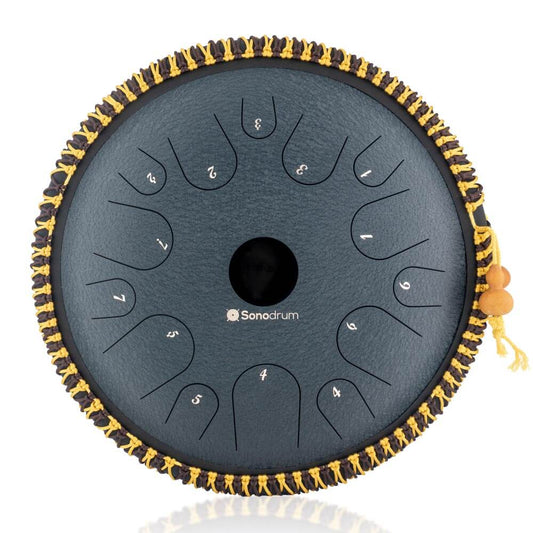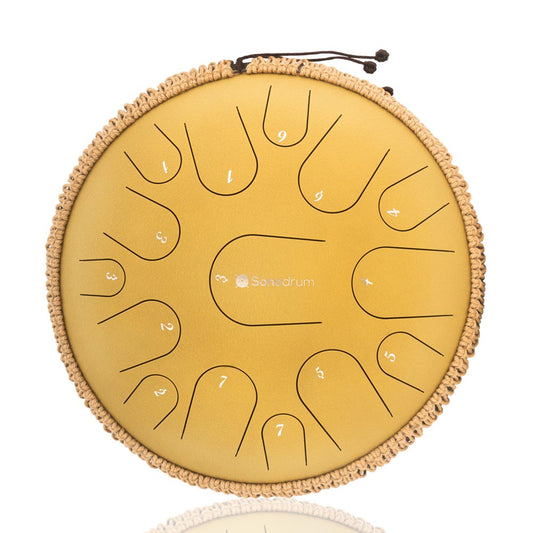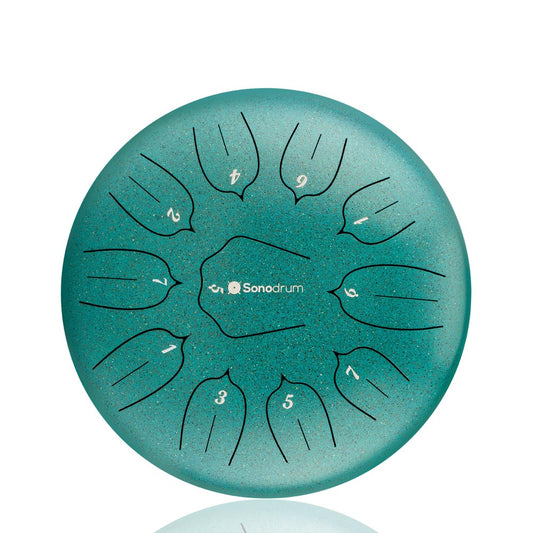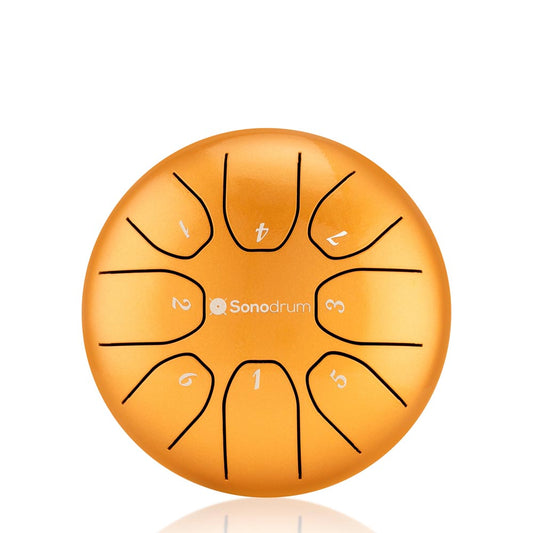Welcome to the world of tongue drums. This fascinating instrument can create amazing sounds and melodies. You can start with beginner tongue drum tutorials to learn the basics.
The tongue drum is perfect for exploring new musical paths. It's great for those who want to learn through beginner tutorials. Mastering it can be both fun and rewarding.
To begin, it's key to understand the basics. Start with beginner tongue drum tutorials. As you get better, you can dive into more advanced techniques.
Introduction to the Tongue Drum
The tongue drum offers endless creative possibilities. It's perfect for those who want to learn and play. You can go from simple melodies to complex rhythms.
Key Takeaways
- Learn the basics of tongue drum how to play through beginner tongue drum tutorials
- Understand the unique sound and versatility of the tongue drum
- Mastering tongue drum techniques can be a fun and rewarding experience
- Start with simple melodies and progress to complex rhythms
- Explore the creative possibilities of the tongue drum
Discovering the Magic of Tongue Drums
Starting your journey with tongue drums is exciting. You'll learn about the playing tongue drum basics and its rich history. Tongue drums have ancient roots and have evolved over time. Today, you can find many types, each with its own sound.
To start playing, it's key to know the different types of tongue drums. You'll find pentatonic, diatonic, and chromatic drums. Each offers a unique sound and playing experience. As you learn, you'll master playing techniques and create your own music.
Playing the tongue drum has many benefits. It can help with stress, improve your mind, and boost creativity. As you get better, you'll find it's both therapeutic and fun. It's a great way to express yourself and connect with others through music.
Here are some tips for starting your tongue drum journey:
- Choose the right type of tongue drum for your needs and skill level
- Practice regularly to develop your skills and technique
- Experiment with different genres and styles to find your unique sound
Essential Equipment for Your Tongue Drum Journey
To start your tongue drum journey, you need the right gear. A guide on playing tongue drum suggests starting with the basics. This includes the tongue drum, mallets or sticks, and a comfy playing area. When picking your tongue drum, think about its size, material, and sound quality.
Here are some key factors to consider when choosing your equipment:
- Size: Tongue drums vary in size. Choose one that feels right for you.
- Material: The material affects the sound. Pick one that sounds good to you.
- Mallets or sticks: The right tools can improve your play. Try different types to find your favorite.
As you start playing, remember to follow tongue drum playing tips to get better. Keeping your tongue drum in good shape is key. Clean and tune it regularly to keep the sound quality up.
https://youtube.com/watch?v=Hg9FswG1hQA
Investing in the right gear and following a guide on playing tongue drum will help you enjoy playing. With practice and patience, you'll master the techniques and enjoy the benefits of playing the tongue drum.
How to Play the Tongue Drum: Basic Techniques
To start playing the tongue drum, you need to know the basics. This includes how to hold it and where to place your hands. Make sure the drum is at a height that feels right for you. This will help you play better as you get more practice.
Some important things to keep in mind when playing the tongue drum are:
- Proper posture to maintain comfort and control
- Hand placement to produce clear, resonant sounds
- Gentle striking to avoid damaging the drum
When you start playing, focus on using your fingers to make different sounds. Learning to play the tongue drum takes time and effort. But with hard work, you can make beautiful music. Start with simple exercises and then get more complex as you get better.
By following these basic steps and practicing often, you'll get better at playing the tongue drum. The most important thing is to have fun while you learn and improve.
Understanding Your Tongue Drum's Sound Layout
To learn tongue drum techniques, knowing your instrument's sound layout is key. The sound layout shows how notes and sounds are arranged. This knowledge helps you play better and create complex rhythms.
Beginner tongue drum tutorials stress the need to understand the sound layout. It lets you play the instrument easily and discover all its sounds. Start by studying your tongue drum's sound layout and practice different notes and rhythms.
Here are some tips to help you understand your tongue drum's sound layout:
- Start by playing each note individually to get a sense of its pitch and tone.
- Experiment with different rhythms and patterns to see how the notes interact with each other.
- Listen to recordings of experienced tongue drum players to get inspiration and ideas for your own playing.
Follow these tips and practice often to grasp your tongue drum's sound layout. Be patient and enjoy the journey. Learn tongue drum techniques at your own pace and have fun exploring.
Fundamental Rhythms and Patterns
As you get better at playing the tongue drum, it's key to learn different rhythms and patterns. Playing the basics is just the beginning. Now, it's time to explore more complex sounds. Let's look at simple beats, melodic sequences, and traditional patterns.
It's important to practice often and start with simple exercises. This will help you improve your timing and coordination. You'll be able to play more complex patterns easily. Here are some tips for practicing:
- Start with a metronome to improve your timing
- Practice playing along with your favorite songs or rhythms
- Experiment with different dynamics and articulations
By mastering these rhythms and patterns, you'll become a skilled tongue drum player. Always keep practicing and trying to improve. This will help you get better at playing tongue drum basics and mastering tongue drum playing.
Mastering Different Playing Styles
As you get better at playing the tongue drum, you'll see how versatile it is. You can play in many styles. To get good at different styles, it helps to learn tongue drum playing tips and follow a guide on playing tongue drum that fits your music goals. Whether you like improvising, composing, or playing with others, knowing the basics of each style will open up new musical possibilities for you.
Trying out different techniques is key to mastering various styles. You might play with different mallets or use your hands to make unique sounds. Exploring different genres like jazz, rock, or classical can also add variety to your music. By using these tongue drum playing tips in your practice, you'll grow more confident and skilled.
Using a guide on playing tongue drum can give you a clear plan to learn and improve. There are many online resources, tutorials, and workshops that can teach you a lot about playing the tongue drum. By mixing these resources with regular practice and trying new things, you'll soon master different playing styles and become a great tongue drum player.
- Improvisation: creating music on the spot, often in response to a prompt or theme
- Composition: writing and playing your own music, often with a specific structure or form
- Accompaniment: playing with other musicians or instruments, adding harmony or rhythm
By mastering different playing styles and using tongue drum playing tips in your practice, you'll unlock the tongue drum's full potential. You'll enjoy a more rewarding and expressive musical journey.
Advanced Tongue Drum Techniques
As you get better at playing the tongue drum, it's key to learn new ways to play. This will make your sound better and more unique. Tongue drum how to play is not just about hitting the notes. It's about making a sound that touches your listeners.
Advanced techniques include palm muting for a softer sound. You do this by placing your palm on the drumhead. This reduces the vibration and makes a softer tone. You can also use harmonics and overtones to add depth to your music. By trying different ways to strike the drum, you can make your sound richer and more complex.
Practicing speed control is another way to improve. This means playing fast and accurately. It's hard, but with effort, you can get better. Adding these advanced techniques to your practice will help you grow as a musician. You'll make a sound that's truly yours.
- Palm muting for a softer sound
- Harmonics and overtones for added depth
- Speed control for rapid, precise playing
Learning advanced tongue drum techniques takes time and effort. Be patient and keep practicing. Soon, you'll be making beautiful music. With these techniques, you'll become a skilled musician, and tongue drum how to play will come naturally to you.
Incorporating Meditation and Mindfulness
Exploring tongue drum basics can lead to relaxation and mindfulness. It's key to add meditation and mindfulness to your practice. This can make playing more enjoyable and improve your well-being. The steps to play tongue drum can be calming, helping you stay in the moment.
Start by finding a quiet, comfy spot to practice. Take deep breaths, feeling the air move in and out. Then, play the notes and focus on the sound and the mallets in your hands. Let go of stress and just be in the moment.
- Diaphragmatic breathing: Breathe deeply, feeling your belly rise and fall.
- Progressive relaxation: Tense and then relax muscles, starting with your toes and moving up.
- Mindful listening: Listen to the sounds around you, including the tongue drum, and immerse yourself in the experience.
Using these techniques can deepen your connection with the tongue drum. It can bring more calm and focus to your practice. Approach playing tongue drum basics with an open mind and a willingness to explore. This way, you can fully enjoy the therapeutic benefits of this unique instrument.
Care and Maintenance of Your Tongue Drum
To keep your tongue drum sounding great, follow some key tongue drum playing tips and maintenance steps. A well-maintained tongue drum will not only sound better but also last longer. It's important to clean and store it properly to keep it in top shape.
A guide on playing tongue drum must talk about maintenance. Here are some essential tips:
- Regularly clean the tongue drum with a soft cloth to remove dirt and dust.
- Store the tongue drum in a dry, cool place to prevent damage from extreme temperatures or humidity.
- Avoid exposing the tongue drum to direct sunlight or moisture, as this can cause damage to the instrument.
By following these simple tongue drum playing tips and maintenance routines, you can ensure your instrument sounds its best. Always handle your tongue drum with care. It will give you many years of enjoyable playing.
Common Mistakes to Avoid When Playing
As you play and practice the tongue drum, knowing common mistakes is key. These mistakes can slow your progress. Learning techniques for playing tongue drum right is crucial to sound quality and skill.
Playing the tongue drum well means using the right force and striking the right notes. Keeping a steady rhythm is also important. Focus on these basics to build a strong foundation and avoid mistakes.
- Incorrect hand positioning can affect sound quality and make playing complex rhythms hard.
- Not practicing enough can lead to poor muscle memory and slow skill improvement.
- Not warming up before playing can cause injuries and hurt your performance.
Knowing these mistakes and avoiding them can help you improve your techniques for playing tongue drum. This way, you'll become more confident and skilled.
Conclusion: Your Journey with the Tongue Drum
Starting your journey with the tongue drum is exciting. The real joy is in learning and mastering it. This instrument can take you to a place of deep calm and mindfulness. It helps you connect with yourself and the world.
Whether you're new to tongue drums or have been playing for a while, keep exploring. Enjoy the soothing sounds, try different ways of playing, and let the tongue drum be your musical friend.
Keep practicing and don't be shy to ask for help. Learning takes time and effort. With every note, you'll discover more about yourself and your music.
As you keep playing, let the tongue drum's sound fill your heart and soul. It will lead you to a more joyful and fulfilling musical journey. Happy playing!
FAQ
What is a tongue drum?
A tongue drum is a special percussion instrument. It makes soothing sounds. It has a hollow shell with metal plates called "tongues." These are struck with mallets or hands to create sounds.
How do I hold and play a tongue drum?
To hold a tongue drum, place it on your lap or a flat surface. Keep a relaxed posture. Use your hands or mallets to strike the tongues gently and rhythmically.
What are the different types of tongue drums?
There are many types of tongue drums. You can find steel, wooden, and hanpan drums. Each type has its own sound and playing style, letting you explore different music.
What are the benefits of playing the tongue drum?
Playing the tongue drum has many benefits. It can help with stress, improve thinking skills, and boost creativity. It also helps you connect with yourself and relax.
How do I care for and maintain my tongue drum?
It's important to care for your tongue drum. Clean it regularly, store it in a dry place, and tune the tongues. Follow the maker's advice to keep your drum sounding great.
What are some common mistakes to avoid when playing the tongue drum?
Don't use too much force or hit the wrong spots. Keep your hands relaxed and focused. Practice often to avoid mistakes and get better.
How can I incorporate meditation and mindfulness into my tongue drum practice?
The tongue drum is great for meditation and mindfulness. Try breathing exercises and relaxation techniques while playing. This can improve your well-being and connection with the instrument.
Where can I learn more advanced tongue drum techniques?
For advanced techniques, look for tutorials or workshops. You can learn about palm muting, harmonics, and speed control. Working with an experienced teacher can help you improve.




